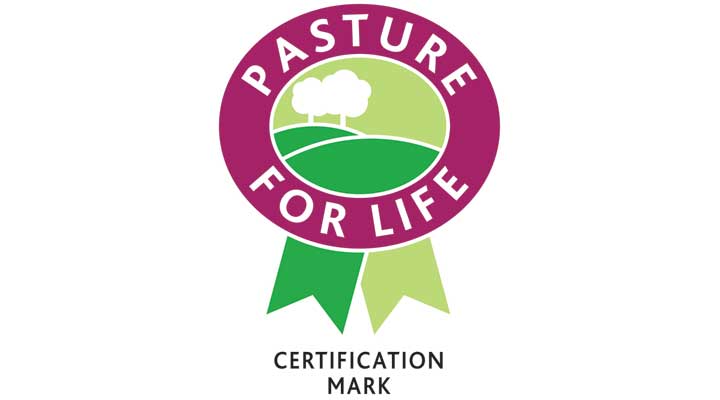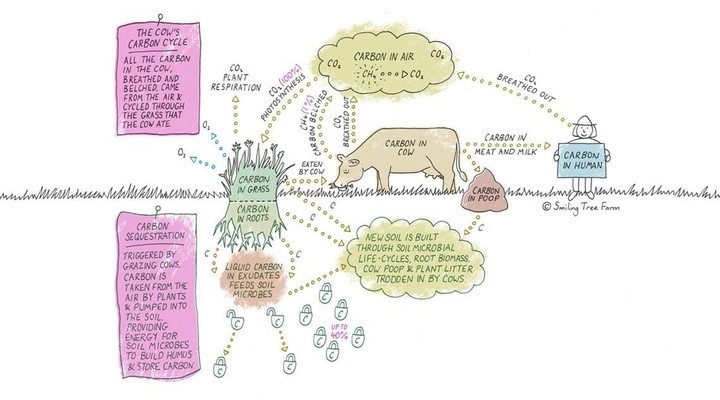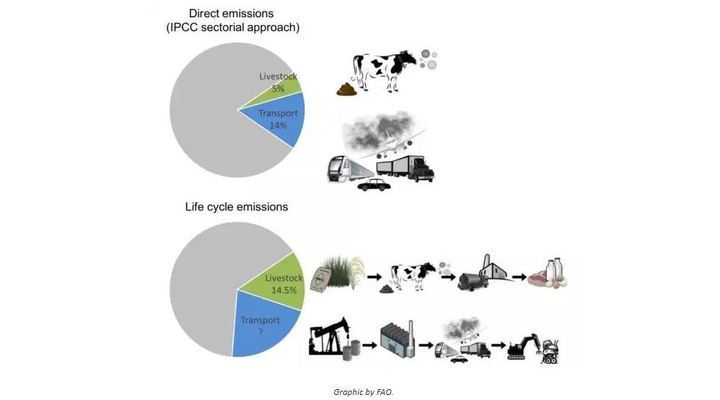Pasture for Life: A solution to global warming
The Pasture-Fed Livestock Association (PFLA) is passionate about cattle and sheep grazing in their natural environment, providing consumers with the very best certified Pasture for Life meat and dairy.

We know that ecologically this makes sense for animals, humans and the planet, but livestock do contribute to climate change. We have looked into this in some detail and published a few answers to common environmental questions raised about livestock, based on latest science and research.
Why are pasture-fed cattle and sheep a better choice for the environment?
- Cattle and sheep can convert grass and other plants that humans cannot eat into meat and milk. Two thirds of farmed land in the UK, and globally, is pasture, so it makes sense to graze cattle and sheep on pasture rather than feeding them grains
- There is growing evidence that well-managed soils using grazing animals can help mitigate global warming
- Farmers that rear their animals on a 100% grass/pasture diet can improve the fertility and productivity of soils through grazing management and the returning of animal manures back to the soil. They also capture carbon in their soils. The effects of drought and flooding are also reduced because the roots of a diverse pasture grow deep – improving soil structure and water retention
But don’t cattle and sheep produce carbon dioxide and methane that cause global warming?
- Cattle and sheep have not caused global warming, but the way in which some are reared intensively, does contribute towards it. The almost universally accepted cause of global warming and associated climate change is mostly due to the burning of fossil fuels since the industrial revolution. Other human activities, including the loss and degradation of ecosystems, forests and soils, have since exacerbated the phenomenon
- Pasture-fed, grain-free production systems such as Pasture for Life, that use existing pastures or have been converted from crop production and do not involve the destruction of forests or other ecosystems, have the potential to be carbon-neutral, when combined with mitigation schemes such as agro-forestry, according to Oxford University scientists
- Methane emissions directly from the digestive system of grazing animals can exacerbate global warming but only if cattle and sheep populations increase. Why? Methane has a big immediate effect but a short lifespan, unlike carbon dioxide that persists in the atmosphere for much longer. Herds that have existed for generations at a stable size will not be adding directly to global warming with their methane emissions
- Methane emissions are part of the natural carbon cycle but the burning of fossil fuels and intensive agriculture has disrupted the stabilising effect of this cycle. Other less climate responsible systems do add significantly to global warming but a move to agroecological systems like Pasture for Life, that help rebuild soils and managing farmland to maximise carbon capture, will increase carbon sequestration and can help combat global warming
 Credit: Smiling Tree Farm
Credit: Smiling Tree Farm
Haven’t I seen that cattle produce more Greenhouse Gas (GHG) emissions than ALL transportation?
- This was the conclusion made by the UN Food and Agriculture Organisation (FAO) in 2006. However, the study upon which it was based did not compare like with like. It compared the total amount of GHG produced over the lifetime of an animal, known as the Life Cycle Emission (LCE) with just the direct emissions, not the full LCE of transport. This is relevant because transport produces GHG in other ways as well – through vehicle manufacturing, the extraction and refining of fuel, plus road and infrastructure construction and maintenance. The comparison was therefore very misleading and has now been corrected with only 5% of direct emissions being attributed to ALL livestock (including those intensively produced) compared to 14% for transport
- Grazing animals fed on pasture only and no grains have few, if any additional LCEs
Why are pasture-fed cattle and sheep better to eat than grain-fed?
- Intensively reared, grain-fed livestock consume around one third of global grain production. It can take up to 7kg of grain to produce 1kg of beef on some intensive farms. This is an inefficient use of resources
- Livestock produced using grains rely heavily on fossil fuels to grow, harvest, process and transport the grain, which is then fed to the animals. In contrast, pasture-fed cattle and sheep rely on existing grasslands and very little use of additional inputs
- Pasture for Life farming methods allow cattle and sheep to eat a natural diet and meet their behavioural needs. Animal welfare organisation Compassion in World Farming says this offers the best potential for high animal welfare
- Grain-free meat and dairy products have proven health benefits including lower total fats, increased omega-3 fatty acids and increased vitamins and minerals garnered from the animals eating only pasture plants
If intensively reared livestock use less land per animal and emit less GHG emissions, aren’t chickens and pigs the answer to sustainable food production?
- Intensive livestock farms have a high use of fossil fuels through the production of feed and fertiliser, transport, electricity etc., which also add to their GHG emissions. Poultry production, which along with pig production relies on land to grow grains to feed, can be shown to have a higher environmental footprint than pasture-fed cattle in terms of land and water use, and also causes nitrate pollution due to the fertiliser used to grow the grains
- Intensively grown grains have resulted in significant soil degradation and loss on arable farms. This is now considered a serious problem for the UK, with some claiming less than 60 years of harvest left. This can be remedied by re-introducing pasture and grazing animals as part of a mixed farming system, with both pasture and dung helping to rebuild soil fertility
- Findings from the ‘Ten years for Agroecology Report’ shows how if we stop feeding ALL animals with grains we can feed the growing population of Europe in 2050 with organic farming methods. This mirrors a report produced by the FAO in 2013, which shows how this could be achieved at a global level
What about biodiversity?
- Farmers, who take a more natural approach to farming by feeding their cattle and sheep only on pasture, inevitably introduce a wide range of wildlife into their fields. They allow their pastures to grow tall, sow a mixture of grasses and herbs, and plant trees and hedgerows, all of which build carbon in the soil
- The UK has lost 97% of its wildflower meadows since the 1950s. These can be successfully restored but need grazing animals to do so effectively. Other rare grassland wildlife habitats also need grazing animals to sustain them
- Rewilding, where land is allowed to go back to nature, has benefits for increasing biodiversity and reversing the harms of historic land use change, but it does not produce food. So, this could be part of the solution in some places, in particular where livestock are used to restore good ecological balance
Can I still eat beef, lamb, cheese and drink milk with a clear conscience if it has come from animals that have been pasture-fed?
- Yes, providing it is labelled with the ‘Pasture for Life’ certification mark, meaning it will have come from animals reared exclusively on a pasture diet with no grains fed at any time
Where can I find out more?
Some scientific research has been linked in the text above. Further information is also available via the following recommended Reading List.
Help spread the message
Help the PFLA spread the positive environmental messages of 100% pasture-fed cattle and sheep.
Share this article on social media, tell your friends and start a discussion about the benefits of rearing and eating certified ‘Pasture for Life’ beef, lamb and dairy.
Subscribe to the Pasture for Life newsletter for further updates or become more involved by becoming a member of the PFLA.




